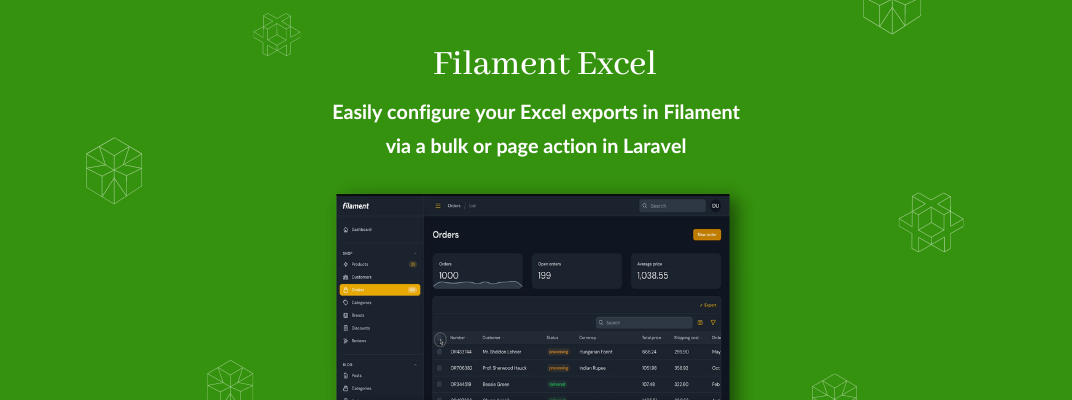Blog Detail
30
Nov
arrow_back Easily Configure Excel Exports in Filament via page action
Filament Excel is an awesome package that helps you to easily configure your Excel exports in Filament via a bulk or page action.
Installation
You can install this package via composer. This will download the package and Laravel Excel. This package
requires PHP 8.0 and Filament 2.0
composer require pxlrbt/filament-excel
For Laravel 9
composer require psr/simple-cache:^2.0 pxlrbt/filament-excel
Quickstart
Starting with v0.2 Filament Excel should work with both filament/filament and filament/tables packages. The most simple usage is just adding ExportBulkAction to your bulk actions.
Example for admin package
<?php
namespace App\Filament\Resources;
use pxlrbt\FilamentExcel\Actions\Tables\ExportBulkAction;
class UserResource extends Resource
{
public static function table(Table $table): Table
{
return $table
->columns([
//
])
->bulkActions([
ExportBulkAction::make()
]);
}
}
Example for table package
<?php
namespace App\Filament\Resources;
use pxlrbt\FilamentExcel\Actions\Tables\ExportBulkAction;
public function getTableBulkActions()
{
return [
ExportBulkAction::make()
];
}
Usage
Filament Excel comes with three actions you can use:
Actions\Tables\ExportBulkActionfor table bulk actionsActions\Tables\ExportActionfor table header actionsActions\Pages\ExportActionfor record pages
Without further configuration, they will try to resolve the fields from the table or form definition and output an Excel file.
Multiple export classes
You can overwrite the default export class and also configure multiple exports with different settings. The user will be shown a modal to select the export class he wants to use.
use pxlrbt\FilamentExcel\Actions\Tables\ExportAction;
use pxlrbt\FilamentExcel\Exports\ExcelExport;
ExportAction::make()->exports([
ExcelExport::make('table')->fromTable(),
ExcelExport::make('form')->fromForm(),
])
Closure customization
Many of the functions for customizing the export class, accept a Closure that gets passed dynamic data:
use pxlrbt\FilamentExcel\Actions\Tables\ExportAction;
use pxlrbt\FilamentExcel\Exports\ExcelExport;
ExportAction::make()->exports([
ExcelExport::make('table')->withFilename(fn ($resource) => $resource::getLabel()),
])
Filename
The filename is set via ->withFilename():
use pxlrbt\FilamentExcel\Actions\Tables\ExportAction;
use pxlrbt\FilamentExcel\Exports\ExcelExport;
ExportAction::make()->exports([
// Pass a string
ExcelExport::make()->withFilename(date('Y-m-d') . ' - export'),
// Or pass a Closure
ExcelExport::make()->withFilename(fn ($resource) => $resource::getLabel())
])
Export types
You can set the file type via ->withWriterType():
use pxlrbt\FilamentExcel\Actions\Tables\ExportAction;
use pxlrbt\FilamentExcel\Exports\ExcelExport;
ExportAction::make()->exports([
ExcelExport::make()->withWriterType(\Maatwebsite\Excel\Excel::XLSX),
])
This package has a lot of features and options wit code examples, For more details, please visit Github.
Published at : 30-11-2022
Rizwan Aslam
I am a highly results-driven professional with 12+ years of collective experience in the grounds of web application development especially in laravel, native android application development in java, and desktop application development in the dot net framework. Now managing a team of expert developers at Codebrisk.

Launch project
